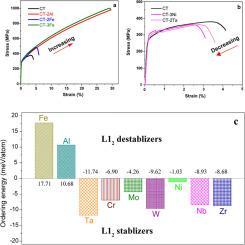当前位置:
X-MOL 学术
›
Acta Mater.
›
论文详情
Our official English website, www.x-mol.net, welcomes your
feedback! (Note: you will need to create a separate account there.)
Suppressing embrittlement and enhancing thermal resistance of bulk superlattice alloys by controllable grain-boundary segregation
Acta Materialia ( IF 8.3 ) Pub Date : 2024-11-19 , DOI: 10.1016/j.actamat.2024.120582 Wei-hong Liu, Xiao-qiang Zhuang, Wei-wei Xu, He-wen Chen, Jun-yang He, Yi-lu Zhao, Shan-shan Lu, Xin-huan Chen, Xingjun Liu, Tao Yang
Acta Materialia ( IF 8.3 ) Pub Date : 2024-11-19 , DOI: 10.1016/j.actamat.2024.120582 Wei-hong Liu, Xiao-qiang Zhuang, Wei-wei Xu, He-wen Chen, Jun-yang He, Yi-lu Zhao, Shan-shan Lu, Xin-huan Chen, Xingjun Liu, Tao Yang

|
Severe grain-boundary embrittlement at ambient temperatures poses one of the most critical challenges for wide applications of superlattice alloys as high-performance structural materials. Indispensable active constituents like Al are recognized as the major cause of such embrittlement by releasing atomic hydrogen from moisture, which violently weakens grain boundaries (GBs) and promotes stress localization. Challenging conventional wisdom, here we surprisingly discover an anomalous ductilization effect in the L12-structured Co3Ti alloys, where Al alloying conversely suppresses the intergranular brittleness and meanwhile dramatically increases tensile ductility from ∼4.1% to 30%. Further experiments and calculations revealed that the grain-boundary brittleness in bulk L12 Co3Ti alloys is directly related to the preservation of L12 chemical order up to the boundary plane, which fortunately, can be destroyed by inducing Co-atom segregation through the alloying of a L12 destabilizer Al, as well as Fe. Such chemical-partitioning-induced disordered intergranular buffer significantly reduces the resistance to dislocation slip across GBs, which retards the development of slip-induced stress concentrations at GBs and hence reduces the likelihood of intergranular fracture. Moreover, the Co-atom segregation-induced grain-boundary phase together with the secondary L21 Co2AlTi phase in the Al-alloyed alloy significantly improves thermal resistance to grain coarsening. The kinetic exponent and apparent activation energy for grain boundary migration in unalloyed Co3Ti increases dramatically from 3.2 and 263.7 kJ/mol to 5.2 and 641.0 kJ/mol, which surpass documented values of Ni- and Co- based superalloys, suggesting their promising potential as heat-resistant materials. These findings pave a new way for developing high-performance, heat-resistant superlattice alloys.
中文翻译:

通过可控晶界偏析抑制块状超晶格合金的脆化并提高热阻
环境温度下严重的晶界脆化是超晶格合金作为高性能结构材料的广泛应用面临的最关键挑战之一。像 Al 这样不可或缺的活性成分被认为是这种脆化的主要原因,它从水分中释放出氢原子,这会猛烈地削弱晶界 (GB) 并促进应力局部化。挑战传统观点,在这里我们出人意料地在 L12 结构的 Co3Ti 合金中发现了异常的延展效应,其中 Al 合金化反而抑制了晶间脆性,同时将拉伸延展性从 ∼4.1% 显着提高到 30%。进一步的实验和计算表明,块体 L12 Co3Ti 合金中的晶界脆性与 L12 化学序的保持直接相关,直到边界平面,幸运的是,可以通过 L12 不稳定剂 Al 和 Fe 的合金化诱导共原子偏析来破坏它。这种化学分配诱导的无序晶间缓冲器显著降低了跨 GB 的位错滑移阻力,从而延缓了 GB 处滑移诱导应力集中的发展,从而降低了晶间断裂的可能性。此外,Al合金合金中Co原子偏析诱导的晶界相以及次级L21 Co2AlTi相显著提高了对晶粒粗化的热阻力。非合金 Co3Ti 中晶界迁移的动指数和表观活化能从 3.2 和 263.7 kJ/mol 急剧增加到 5.2 和 641。0 kJ/mol,超过了 Ni 和 Co 基高温合金的记录值,表明它们作为耐热材料的潜力很大。这些发现为开发高性能、耐热的超晶格合金铺平了一条新道路。
更新日期:2024-11-19
中文翻译:

通过可控晶界偏析抑制块状超晶格合金的脆化并提高热阻
环境温度下严重的晶界脆化是超晶格合金作为高性能结构材料的广泛应用面临的最关键挑战之一。像 Al 这样不可或缺的活性成分被认为是这种脆化的主要原因,它从水分中释放出氢原子,这会猛烈地削弱晶界 (GB) 并促进应力局部化。挑战传统观点,在这里我们出人意料地在 L12 结构的 Co3Ti 合金中发现了异常的延展效应,其中 Al 合金化反而抑制了晶间脆性,同时将拉伸延展性从 ∼4.1% 显着提高到 30%。进一步的实验和计算表明,块体 L12 Co3Ti 合金中的晶界脆性与 L12 化学序的保持直接相关,直到边界平面,幸运的是,可以通过 L12 不稳定剂 Al 和 Fe 的合金化诱导共原子偏析来破坏它。这种化学分配诱导的无序晶间缓冲器显著降低了跨 GB 的位错滑移阻力,从而延缓了 GB 处滑移诱导应力集中的发展,从而降低了晶间断裂的可能性。此外,Al合金合金中Co原子偏析诱导的晶界相以及次级L21 Co2AlTi相显著提高了对晶粒粗化的热阻力。非合金 Co3Ti 中晶界迁移的动指数和表观活化能从 3.2 和 263.7 kJ/mol 急剧增加到 5.2 和 641。0 kJ/mol,超过了 Ni 和 Co 基高温合金的记录值,表明它们作为耐热材料的潜力很大。这些发现为开发高性能、耐热的超晶格合金铺平了一条新道路。


















































 京公网安备 11010802027423号
京公网安备 11010802027423号